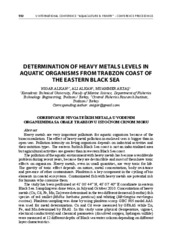Determination Of Heavy Metals Levels In Aquatic Organisms From Trabzon Coast Of The Eastern Black Sea
Određivanje nivoa teških metala u vodenim organizmima sa obale Trabzon u istočnom Crnom moru
| dc.contributor.author | Alkan, Nigar | |
| dc.contributor.author | Alkan, Ali | |
| dc.contributor.author | Aktas, Muammer | |
| dc.date.accessioned | 2015-10-12T17:33:44Z | |
| dc.date.available | 2015-10-12T17:33:44Z | |
| dc.identifier.uri | http://arhiva.nara.ac.rs/handle/123456789/1031 | |
| dc.description.abstract | Heavy metals are very important pollutants for aquatic organisms because of the bioaccumulation. The effect of heavy metal pollution in enclosed seas is bigger than in open seas. Pollution intensity on living organisms depends on industrial activities and their nutrition types. The eastern Turkish Black Sea coast is not an industrialized area but agricultural activities are greater than in western Black Sea coast. The pollution of the aquatic environment with heavy metals has become a worldwide problem during recent years, because they are destructible and most of them have toxic effects on organisms. Heavy metals, even in small quantities, are very toxic for life. The gravity of toxic effect depends on nature, metal concentration, body resistance and presence of other contaminants. Plankton is a key component in the cycling of bio elements in coastal ecosystems. Contaminated fish with heavy metals are potential risk for humans who consume them. The study has been performed at 41º 00’ 44” N, 40º 07’ 40” E coordinate in eastern Black Sea. Sampling was done twice, in July and October 2010. Concentration of heavy metals (Cu, Cd, Fe, Mn, Zn) were determined in the two different demersal (benthic) fish species of red mullet (Mullus barbatus ponticus) and whiting (Merlangius merlangus euxinus). Plankton sampling was done by using plankton scoop. GBC 905 model AAS was used for metal determination. Cu and Cd were measured by GFAAS while Zn, Fe, and Mn determined by FAAS. In this study some physical (temperature, sigma-t, electrical conductivity) and chemical parameters (dissolved oxygen, hydrogen sulfide) were measured at 12 different depths of Black sea water column depending on different layer characteristics. Metal concentration determined in whiting, red mullet and plankton respectively as mg/kg of dry weight; Cu 0,329±0,131; 0,362±0,260; 18,4±8,1 and Zn 17,3±1,8; 24,0±8,6; 1218±959 and Fe 10,1±4,2; 28,6±12,3; 4366±526 and Mn 0,5±0,1; 1,0±0,3; 6299±3761 and Cd 0,207±0,034; 0,208±0,070; 50,1±18,9. The results showed that metal concentrations in plankton are higher than in fish species. | en |
| dc.subject | heavy metals | en |
| dc.subject | aquatic organisms | en |
| dc.subject | Cu | sr |
| dc.subject | Cd | sr |
| dc.subject | Zn | sr |
| dc.subject | Fe | en |
| dc.subject | Mn | sr |
| dc.title | Determination Of Heavy Metals Levels In Aquatic Organisms From Trabzon Coast Of The Eastern Black Sea | en |
| dc.title.alternative | Određivanje nivoa teških metala u vodenim organizmima sa obale Trabzon u istočnom Crnom moru | sr |
Files in this item
This item appears in the following Collection(s)
-
5. International Conference “Aquaculture & Fishery” Faculty of Agriculture, Belgrade-Zemun, Serbia, June, 1 - 3. 2011.
http://www.cefah.agrif.bg.ac.rs/konferencija/konferencija.html



